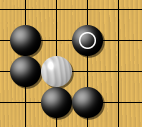
In the game of Go, shape describes the positional qualities of a group of stones. Descriptions of shapes in go revolve around how well a group creates or removes life and territory. Good shape can refer to the efficient use of stones in outlining territory, the strength of a group in a prospective fight, or making eye shapes so that a group may live. Bad shapes are inefficient in outlining territory and are heavy. Heavy groups cannot easily make eye shapes and are therefore good targets for attack. Understanding and recognizing the difference between good shape and bad is an essential step in becoming a stronger player.
Contents
Shape is not a rule; the surrounding position must always be taken into account. While it is useful for beginners to learn the common good and bad shapes presented here, sometimes a usually bad shape can be the best shape to play locally. This can be true if it forces the opponent to create an equally bad or worse shape, or if it accomplishes a specific tactical goal, such as the creation of eye-shape or the capture of an opponent's group.
"To make shape is to take a weak or defective position...and transform it into a strong one. Sometimes this can be done just by putting one stone down in the right place, but usually it takes sacrifice tactics...." [1] : 164